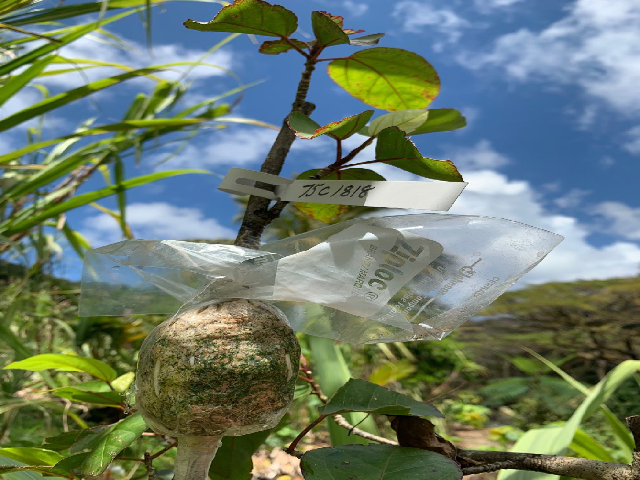As you walk through the Valley these days, you’re likely to see branches of trees and shrubs sporting
tennis-ball sized white plastic-covered bulges. These are air-layers. This is a propagation technique used
on plants which are difficult or almost impossible to grow from cuttings. It can take over two months to
take, resulting in a genetically identical plant which starts a whole new life span. This is crucially useful at Waimea Valley where we have so many wild-collected plants which have become extremely rare or
can no longer be found where they were collected.
To properly air layer, choose a (usually) vertical branch of less than a baby finger’s width that has a fair amount of healthy leaves. First, girdle the branch with two incisions around its circumference about an inch apart. An exacto blade that has been slightly dulled by rubbing the blade on a stone works well for this. The two incisions go down to the slimy layer of meristem below the dry bark. After a vertical cut between them, remove an inchlong “collar” of bark with your thumbnail. Make sure that there are no green “stripes” along the inch of exposed meristem which could allow nutrients to flow from the plant to the branch being airlayering. At this point the plumbing has been isolated except for the inner, woodier part of the branch. Apply rooting hormone, a powder you can get from most garden shops to the open wound with a tooth brush. Surround the wound with long-fiber New Zealand sphagnum moss from which almost all the
water has been squeezed. The “art” of airlayering is tightly surrounding the sphagnum with clear plastic, hermetically sealing it so that moisture can’t escape for the two months or so it will take for roots
to grow. When you see plenty of roots climbing on the inside of the plastic, it’s time to cut off the airlayered branch, remove the plastic, give it a soak in diluted Superthive, then pot it up.
People used this technique even before plastic sheeting was widely available. A 1930’s propagation book from Ceylon/Sri Lanka tells of binding the sphagnum moss with raphia strips and suspending a water-filled coconut shell above it with a pinhole to drip onto the airlayer. We use a wonderful plastic/wax stretchable tape called “parafilm” to help seal the ends of the plastic. Sometimes airlayers fail when rainwater wicks into the almost dry sphagnum. We avoid this by parafilming a larger piece of clear plastic over the whole airlayer to act like an umbrella.
Half-hour classes in airlayering are offered at Waimea Valley when requested. It requires a lot of practice to seal the plastic properly. If, as a Waimea volunteer, you are able to make two good rooted airlayers on a hibiscus hybrid or anything pre-approved, you get to keep one.



